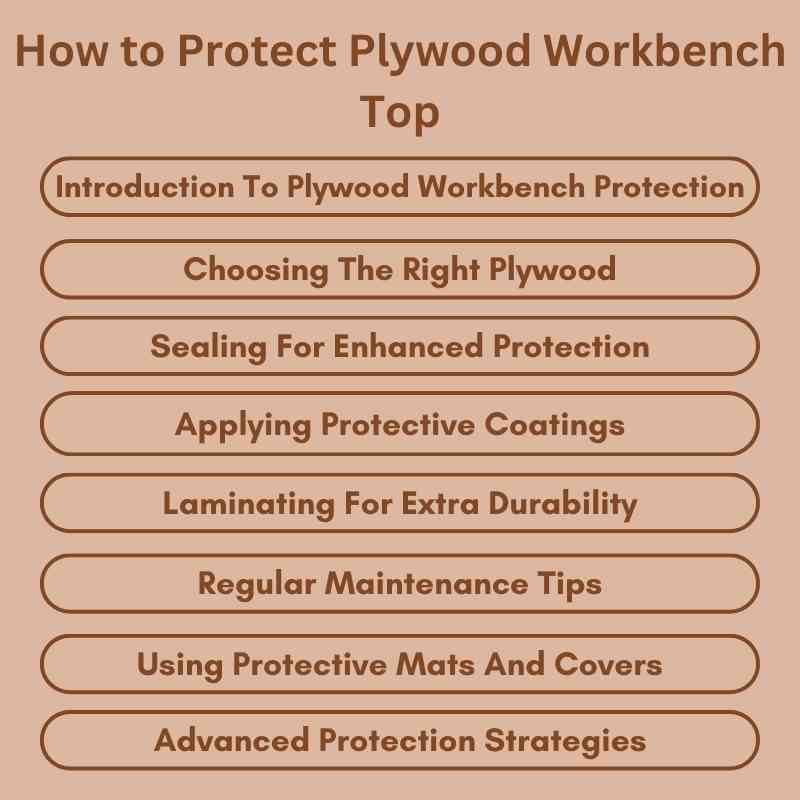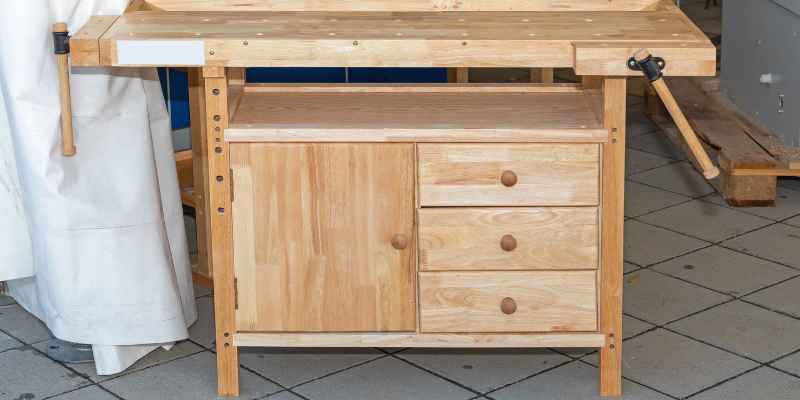To protect a plywood workbench top, apply a durable sealant or finish. Regularly clean the surface to prevent damage from spills and scratches.
A plywood workbench serves as a versatile workspace for various projects. Protecting its surface is essential for longevity and functionality. Without proper care, plywood can easily suffer from scratches, moisture damage, and stains. Using a sealant not only guards against these issues but also enhances the wood’s appearance.
Regular maintenance, including cleaning and reapplying finishes, keeps the workbench in prime condition. Whether you’re a hobbyist or a professional, understanding how to care for your workbench is crucial. This guide will provide effective strategies to ensure your plywood workbench top remains in excellent shape for years to come.
Introduction To Plywood Workbench Protection
Protecting a plywood workbench top is very important. Durability ensures it lasts longer. A strong workbench can handle heavy tools and projects.
Challenges often arise from moisture and scratches. Water can warp the plywood over time. Scratches can weaken the surface and make it look bad.
Using a protective finish helps prevent these issues. Options like varnish or polyurethane create a strong barrier. Regular maintenance is key to keeping the surface intact.
Cleaning the workbench regularly removes dirt and dust. This simple step helps maintain its appearance and strength.

Choosing The Right Plywood
Choosing the right plywood for a workbench is essential. Various types of plywood offer different benefits. Softwood plywood is lightweight and easy to work with. Hardwood plywood is durable and resists wear. Marine plywood is water-resistant and ideal for wet areas.
Consider the thickness of the plywood. Thicker plywood provides better strength and stability. Grade also matters; higher grades have fewer defects. Look for plywood that is void-free for a smoother surface.
| Type of Plywood | Best For |
|---|---|
| Softwood | General use |
| Hardwood | Heavy-duty projects |
| Marine | Wet environments |
Sealing For Enhanced Protection
Sealing plywood workbench tops offers many benefits. First, it protects against moisture. This helps prevent warping and swelling. Sealed surfaces are also easier to clean.
Using sealants can enhance durability. They create a barrier against stains and spills. A good sealant can extend the life of your workbench.
| Sealant Type | Benefits |
|---|---|
| Polyurethane | Strong and water-resistant |
| Epoxy | Very durable and chemical-resistant |
| Varnish | Enhances wood grain and provides a glossy finish |
| Oil-based Sealers | Penetrates deeply and provides good moisture resistance |
Applying Protective Coatings
Protecting your plywood workbench top is essential for durability. Applying protective coatings can prevent damage from moisture and scratches. Several types of coatings can be used.
| Type of Coating | Description |
|---|---|
| Polyurethane | Offers strong protection and a glossy finish. |
| Varnish | Provides a durable, water-resistant layer. |
| Oil | Enhances wood grain and offers basic protection. |
| Wax | Easy to apply and gives a natural look. |
The application process is straightforward. Start by cleaning the surface. Ensure it is free of dust and debris. Apply the chosen coating with a brush or roller. Follow the manufacturer’s instructions for drying times. Repeat this process for a thicker finish if needed.
Laminating For Extra Durability
Laminating plywood enhances its durability and strength. This process offers several key benefits.
- Improved resistance to scratches and dents.
- Waterproofing helps prevent damage from spills.
- Easier cleaning makes maintenance simple and quick.
- Extended lifespan ensures your workbench lasts longer.
Different lamination techniques exist to suit your needs. Options include:
| Technique | Description |
|---|---|
| Hot Lamination | Uses heat and pressure for strong bonding. |
| Cold Lamination | Adhesive applied without heat; easier to handle. |
| Edge Banding | Seals edges to prevent moisture entry. |
Regular Maintenance Tips
Keeping your plywood workbench top clean is very important. Use a soft cloth for regular dusting. A gentle cleaner can help remove stains without damaging the surface.
Protect the wood by avoiding harsh chemicals. Always wipe up spills quickly to prevent water damage. Applying a wood conditioner every few months can help maintain the finish.
For damage prevention, use a protective cover when not in use. Avoid placing heavy objects directly on the surface. Always use cutting boards or mats when working with sharp tools.
Storing tools properly can also prevent scratches. Keep the workspace organized to reduce accidents. Regularly check for signs of wear or damage.
Using Protective Mats And Covers
Using protective mats and covers on a plywood workbench top offers many benefits. These items help to prevent scratches, dents, and other damages. They also keep the surface clean and free from spills.
Recommendations for protective mats include using those made from durable materials. Rubber or foam mats work well for cushioning and support. Covers should be water-resistant and easy to clean. Look for covers that fit snugly to avoid slipping.
| Type | Benefits |
|---|---|
| Rubber Mat | Offers great grip and protection |
| Foam Mat | Provides cushioning for work |
| Water-Resistant Cover | Keeps surface dry and clean |
Advanced Protection Strategies
Protecting a plywood workbench top is essential. Using innovative materials can enhance durability. Options like epoxy resin provide a strong, waterproof layer. Polyurethane finishes are also great for scratch resistance.
Future trends include biodegradable coatings. These are eco-friendly and effective. Smart materials might also become popular. They can adjust to temperature and humidity changes.
| Material | Benefits |
|---|---|
| Epoxy Resin | Waterproof, strong, durable |
| Polyurethane Finish | Scratch resistant, easy to apply |
| Biodegradable Coatings | Eco-friendly, effective protection |
| Smart Materials | Adaptive to environmental changes |

Frequently Asked Questions
How Do I Seal A Plywood Workbench Top?
Sealing a plywood workbench top is essential for longevity. Use a polyurethane or epoxy sealer for protection against moisture and spills. Apply multiple coats for better durability. Ensure proper drying time between coats to achieve a smooth finish. This will significantly enhance the workbench’s lifespan and maintain its appearance.
What Finish Is Best For Plywood Workbench Tops?
The best finishes for plywood workbench tops include polyurethane, varnish, or oil. Each finish offers varying levels of protection and aesthetics. Polyurethane provides a hard, waterproof surface, while oil enhances the natural wood grain. Choose based on your usage and preference for durability or appearance.
How Often Should I Maintain My Workbench Top?
Regular maintenance of your workbench top is crucial. Aim to clean and inspect it every month. Reapply your chosen finish annually or as needed. This will prevent wear and tear, keeping the surface functional and visually appealing. Regular upkeep extends the life of your workbench significantly.
Can I Use Plywood For Heavy-duty Workbenches?
Yes, plywood can be used for heavy-duty workbenches. Opt for thicker plywood, such as 3/4 inch or more, for added strength. Reinforce the structure with adequate supports to handle heavy loads. Properly sealing the surface will also enhance its durability under heavy use.
Conclusion
Protecting your plywood workbench top is essential for longevity and functionality. Use sealants, mats, and regular maintenance to keep it in top shape. Investing time in care will enhance your workspace efficiency. By following these tips, you ensure your workbench remains a reliable tool for all your projects.
Keep it protected and enjoy your craftsmanship!

